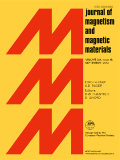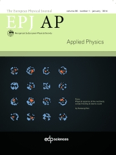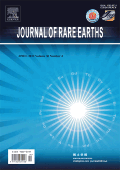
JOURNAL OF MAGNETISM AND MAGNETIC MATERIALS
Scope & Guideline
Charting New Territories in Magnetism
Introduction
Aims and Scopes
- Research on Magnetic Materials:
The journal emphasizes studies on various types of magnetic materials, such as permanent magnets, soft magnetic materials, and magnetic semiconductors, focusing on their synthesis, characterization, and performance. - Magnetocaloric and Thermodynamic Effects:
A significant area of research includes the exploration of magnetocaloric effects and thermodynamic properties, which are crucial for applications in magnetic refrigeration and energy storage technologies. - Spintronics and Magnetic Dynamics:
The journal features works on spintronics, including spin transport phenomena, spin-torque effects, and the dynamics of magnetic textures, which are essential for next-generation information technologies. - Magnetic Characterization Techniques:
Papers often discuss innovative characterization techniques, such as magnetometry, electron microscopy, and neutron scattering, which are vital for understanding the magnetic properties at various scales. - Theoretical and Computational Studies:
The journal includes theoretical and computational studies that model magnetic interactions, phase transitions, and other phenomena, providing insights that complement experimental findings.
Trending and Emerging
- Magneto-Optical and Spintronic Applications:
Research on magneto-optical effects and spintronic devices is gaining traction, highlighting the integration of magnetic materials with optical and electronic systems for advanced applications. - Magnetic Nanocomposites and Hybrid Materials:
The development of magnetic nanocomposites and hybrid materials, which combine magnetic properties with other functionalities, is increasingly popular, particularly for applications in sensors, electronics, and energy devices. - Sustainable and Green Magnetic Materials:
There is a growing focus on the synthesis and application of eco-friendly and sustainable magnetic materials, reflecting a broader trend towards sustainability in materials science. - Advanced Characterization Techniques:
Emerging techniques such as in-situ characterization and advanced imaging methods are trending, allowing for deeper insights into the magnetic properties and behaviors of materials at the nanoscale. - Machine Learning and Computational Methods:
The application of machine learning and computational modeling in the study of magnetic materials is on the rise, facilitating faster material discovery and optimization processes.
Declining or Waning
- Traditional Permanent Magnet Research:
Research focused solely on traditional rare-earth and ferromagnetic permanent magnets has seen a decrease, likely due to the emerging interest in alternative materials and designs that reduce reliance on rare-earth elements. - Basic Magnetic Characterization:
Studies that primarily concentrate on basic magnetic characterization without exploring advanced applications or novel materials are becoming less frequent, as researchers seek to connect their findings to practical applications. - Single-Material Studies:
There is a noticeable shift away from studies focusing on single materials towards more complex systems, including composites and hybrid materials that combine multiple functionalities.
Similar Journals

INTERNATIONAL JOURNAL OF APPLIED ELECTROMAGNETICS AND MECHANICS
Fostering Collaboration for Tomorrow's TechnologiesINTERNATIONAL JOURNAL OF APPLIED ELECTROMAGNETICS AND MECHANICS (ISSN: 1383-5416, E-ISSN: 1875-8800) is a prominent peer-reviewed journal published by IOS PRESS, based in the Netherlands. Since its inception in 1996, the journal has established itself as a vital resource for researchers, professionals, and students in the interdisciplinary fields of applied electromagnetics and mechanics, covering a broad spectrum of topics including mechanical engineering, electrical and electronic engineering, as well as condensed matter physics. Although it currently operates under a subscription model, its accessibility and relevance are underscored by its rankings in Scopus across several categories: notably, it ranks in the 34th percentile in Mechanical Engineering and 31st in Electrical and Electronic Engineering. With convergence anticipated until 2024, the journal aims to foster innovative research, promote interdisciplinary collaboration, and provide a platform for the latest advancements in electromagnetics and mechanics, thereby contributing significantly to the academic community and industry practices.

JOURNAL OF EXPERIMENTAL AND THEORETICAL PHYSICS
Bridging Theoretical Insights with Experimental RealitiesJournal of Experimental and Theoretical Physics is a distinguished publication in the field of physics, dedicated to disseminating pioneering research and fostering intellectual discourse in both experimental and theoretical domains. Published by Pleiades Publishing Inc, this journal has established itself as a crucial platform for physicists, with a commendable Q3 categorization in the 2023 rankings within Physics and Astronomy, illustrating its impactful contributions to the discipline. The journal features a wide array of articles that delve into the intricacies of physical theory, experimental techniques, and applications, making it an invaluable resource for researchers, professionals, and students alike. Although it operates under a traditional access model, its longstanding history, dating back to 1980 and converging years through to 2023, underscores its commitment to advancing the frontiers of physics knowledge. The journal is also notable for its engagement in the scientific community, aiming to bridge the gap between theoretical predictions and experimental validations. As a part of Pleiades Publishing, it continues to uphold rigorous standards of academic excellence, inviting contributions that push the boundaries of current understanding and stimulate further exploration in the fascinating world of physics.

EUROPEAN PHYSICAL JOURNAL-APPLIED PHYSICS
Innovating Research in Condensed Matter and BeyondEUROPEAN PHYSICAL JOURNAL-APPLIED PHYSICS, published by EDP SCIENCES S A in France, serves as a vital platform for the dissemination of cutting-edge research in the fields of condensed matter physics, electronic, optical and magnetic materials, and instrumentation. With an ISSN of 1286-0042 and E-ISSN of 1286-0050, this journal has been a valuable resource for researchers since its inception in 1998, aiming to foster innovation and dialogue among professionals and academics alike. Featuring an impact factor that reflects its growing influence, the journal is currently ranked in the Q4 quartile for several related categories in 2023, underscoring its ongoing contributions to the scientific community despite its relatively competitive positioning. Access to the journal is available through various Open Access options, ensuring that pioneering research is readily accessible to all. As it continues to evolve towards its 2024 objectives, EUROPEAN PHYSICAL JOURNAL-APPLIED PHYSICS remains dedicated to advancing knowledge and facilitating collaboration in applied physics, making it an essential resource for students, researchers, and professionals dedicated to exploring the forefront of physical sciences.

JOURNAL OF RARE EARTHS
Unveiling the Secrets of Rare EarthsThe JOURNAL OF RARE EARTHS, published by Elsevier, stands as a premier outlet for cutting-edge research in the fields of chemistry and geochemistry, particularly focusing on rare earth elements and their diverse applications. Since its inception in 1993, this esteemed journal has gained significant recognition, achieving a Q1 ranking in Chemistry (Miscellaneous) and a Q2 ranking in Geochemistry and Petrology as of 2023. With a strong position in the Scopus rankings—placing 12th out of 154 in Earth and Planetary Sciences and 69th out of 408 in General Chemistry—this journal is pivotal for scientists and industry professionals seeking to advance their understanding and application of rare earths. Although it is not an open-access publication, access to its comprehensive articles and reviews can be gained through institutional subscriptions, ensuring that valuable research continues to reach a targeted audience. The JOURNAL OF RARE EARTHS is committed to fostering scientific dialogue and innovation, making it an essential resource for researchers, educators, and students alike.

Journal of Advanced Dielectrics
Bridging Theory and Application in Material ScienceThe Journal of Advanced Dielectrics, published by World Scientific Publishing Co Pte Ltd, is a pivotal open-access platform since 2014 dedicated to advancing research in the fields of dielectrics, ceramics, and composites. Based in Singapore, this journal aims to bridge the gap between theoretical developments and practical applications in Electrical and Electronic Engineering, Condensed Matter Physics, and Electronic, Optical, and Magnetic Materials. With an impressive classification in the 2023 Quartile Rankings indicating its significance within its categories, and notable Scopus Rankings that highlight its impact and relevance, this journal serves as a vital resource for scholars and professionals committed to cutting-edge research and innovation. As it continues to flourish through the converging years from 2015 to 2024, the Journal of Advanced Dielectrics stands as an essential conduit for the dissemination of knowledge in advanced material sciences, making it an indispensable asset for today's research community.

EUROPEAN PHYSICAL JOURNAL B
Connecting Researchers with Cutting-Edge DiscoveriesEUROPEAN PHYSICAL JOURNAL B (ISSN: 1434-6028, E-ISSN: 1434-6036), published by Springer, is a prominent international journal based in Germany that focuses on the fields of Condensed Matter Physics and Electronic, Optical and Magnetic Materials. With a converged publication timeline from 1998 to 2024, it caters to a diverse audience that includes researchers, professionals, and students striving for the latest advancements in these vital areas of physics. The journal is recognized with a Q3 ranking in both relevant categories for 2023, showcasing its solid yet notable standing within the academic community. Although currently without an H-index, its Scopus rankings reflect a percentile performance of 41st and 39th, respectively, indicating a growing influence among its peers. The journal offers open access options, ensuring that groundbreaking research is widely accessible and contributes to the collective knowledge within the scientific domain. By aiming to publish high-quality, well-researched articles, the EUROPEAN PHYSICAL JOURNAL B plays a crucial role in disseminating innovative findings and fostering collaboration in the field of physics.

Progress in Superconductivity and Cryogenics
Exploring the Depths of Cryogenic Science and SuperconductivityProgress in Superconductivity and Cryogenics is a distinguished academic journal published by the Korea Institute of Applied Superconductivity & Cryogenics, dedicated to advancing the field of superconductivity and cryogenic technologies. Since its inception in 2009, this journal has served as a pivotal platform for researchers and practitioners, promoting the dissemination of innovative findings and methodologies. Although currently positioned in Q4 quartiles in both Electrical and Electronic Engineering and Electronic, Optical and Magnetic Materials, the journal continually strives for excellence, offering insights that are essential for understanding the complexities of superconducting materials and their applications. While currently not an open-access journal, it provides invaluable research to the global scientific community. The journal's address is located in Changwon, South Korea, and aims to bridge the gap between theoretical research and practical implementation, making it a crucial resource for those engaged in the vibrant study of superconductivity.

Journal of Magnetic Resonance Open
Pioneering Open Access in Magnetic Resonance ApplicationsThe Journal of Magnetic Resonance Open, published by ELSEVIER, is a premier open access journal dedicated to the dissemination of groundbreaking research in magnetic resonance and its applications across various scientific domains. Since its launch in 2019, this journal has carved a niche in the fields of analytical chemistry, electronic, optical, and magnetic materials, as well as radiology and spectroscopy. It holds a commendable position in the academic community, reflected by its 2023 category quartiles, ranking Q2 in both analytical chemistry and electronic materials, and Q3 in radiology and spectroscopy. With an emphasis on open access, Journal of Magnetic Resonance Open provides unrestricted access to research articles, fostering collaboration and innovation. Researchers, professionals, and students will find valuable insights within its pages, contributing to the growing body of knowledge in these dynamic fields, making it an essential resource for staying at the forefront of scientific advancements.

Journal of Superconductivity and Novel Magnetism
Innovating the Future of Magnetic PhenomenaJournal of Superconductivity and Novel Magnetism, published by SPRINGER, is a premier venue for research in the dynamic fields of condensed matter physics and materials science. With an ISSN of 1557-1939 and an E-ISSN of 1557-1947, this journal provides an essential platform for disseminating innovative studies examining the complexities of superconductivity and magnetic phenomena. The journal is recognized for its contributions, holding a Q3 quartile ranking in both condensed matter physics and electronic, optical, and magnetic materials as of 2023. With a commitment to rigor and relevance, it features research that breaks new ground in understanding the properties and applications of superconducting materials, aiming to bridge fundamental science with technological advancements. Despite its lack of open access, the journal remains pivotal for researchers, professionals, and students keen to stay abreast of cutting-edge developments in the field, making it an indispensable resource for cultivating knowledge and promoting collaboration.

Magnetochemistry
Shaping the Future of Magnetic ResearchMagnetochemistry is a premier academic journal dedicated to the study of magnetic phenomena in chemistry, published by MDPI, a globally recognized publisher known for its dedication to open science. Since its inception in 2015, this Open Access journal has provided a platform for researchers to share their findings and innovations in the fields of chemistry, particularly in the areas of electronic, optical, and magnetic materials. With a commendable impact factor and competitive ranking, including Q2 in miscellaneous chemistry and materials chemistry, and achieving notable placements within the Scopus ranks, Magnetochemistry stands out as a vital resource for professionals and students alike. By facilitating access to groundbreaking research, it significantly contributes to the advancement of the field, encouraging collaboration and further exploration among its diverse readership. Located in Switzerland, Magnetochemistry offers not only accessibility through its open access model but also a commitment to high-quality and impactful research outputs.